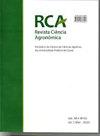限水条件下甜高粱种子的生理成熟
IF 0.7
4区 农林科学
Q3 AGRICULTURE, MULTIDISCIPLINARY
引用次数: 0
摘要
本文章由计算机程序翻译,如有差异,请以英文原文为准。
Physiological maturation of sweet sorghum seeds produced under water restriction
- Sweet sorghum has been shown to be an alternative for ethanol production in several regions. Because it is sexually propagated, the use of quality seeds becomes an important factor for obtaining an adequate plant stand and, consequently, good productivity. Thus, the objective was to evaluate the production and physiological maturation of seeds of sweet sorghum cv. BRS 511, in response to the interval between irrigations during the reproductive period and harvesting period. Two experiments were carried out in a greenhouse, the experimental design adopted was in randomized blocks, with four replications in a 3 x 2 split-plot scheme, corresponding to three intervals between irrigations during the reproductive stage (0; 4 and 8 days) and two harvest times (102 and 110 days after sowing). The following parameters were evaluated from the harvested panicles: number of seeds, weight of one thousand seeds, water content, germination, first germination count, emergence in sand and emergence speed, electrical conductivity and seedling vigor. The production of seeds per panicle and the weight of a thousand seeds were signi fi cantly in fl uenced by the increase in the interval between irrigations in the 2 nd experiment, with a reduction of 50.4 and 46.3%, respectively. Water replacement every eight days caused a reduction of up to 43.4% in the first germination count and 16.3% in germination. The production and quality of sweet sorghum seeds reduces as a function of the increase in the interval between irrigations and the harvesting time, presenting germination rates below the required for commercialization.
求助全文
通过发布文献求助,成功后即可免费获取论文全文。
去求助
来源期刊

Revista Ciencia Agronomica
Agricultural and Biological Sciences-Horticulture
CiteScore
2.00
自引率
0.00%
发文量
41
审稿时长
4-8 weeks
期刊介绍:
To publish technical-scientific articles and study cases (original projects) that are not submitted to other journals, involving new researches and technologies in fields related to Agrarian Sciences. Articles concerning routine analysis, preliminary studies, technical notes and those which merely report laboratorial analysis employing traditional methodology will not be accepted for publication. The Journal of Agronomical Science also has the mission to promote the exchange of experience in the referred fields.
 求助内容:
求助内容: 应助结果提醒方式:
应助结果提醒方式:


